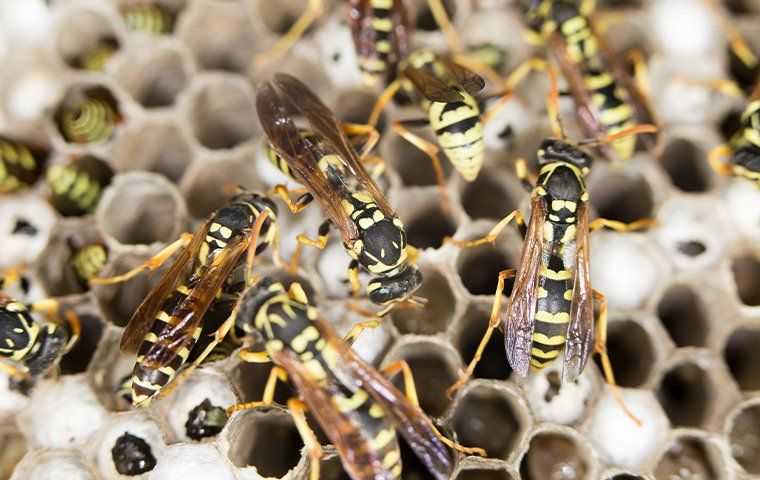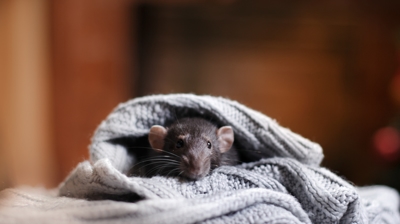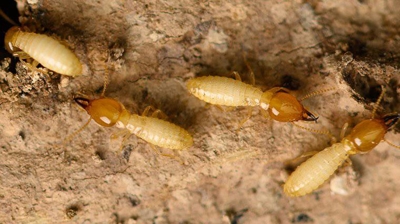
Yellow Jacket Identification & Prevention
Yellow jackets are a type of social wasp characterized by their distinctive black and yellow coloring. These stinging insects are known for their aggressive behavior, especially when defending their nests. Yellow jackets build paper nests, often underground or in protected locations, and live in colonies with a hierarchical structure.
They are scavengers and primarily feed on other insects, nectar, and sugary substances. While yellow jackets play a role in controlling pest populations, their presence can be a concern for humans due to their ability to deliver painful stings, and their nests are best approached with caution to avoid disturbances.
-
"Extremely Satisfied!"
We were super satisfied with Bayonne Exterminating Co. We had a mouse when I was 9 months pregnant and they came right away and took care of our problem.
Christina C. -
"Great Customer Service!"
Great at coordinating and scheduling.
Russell M.
Frequently Asked Questions About Yellow Jackets
Have questions? We are here to help. Still have questions or can't find the answer you need? Give us a call at 201-339-5119 today!
-
What are yellow jackets?
Yellow jackets are a type of stinging insect and eco-important pests. Through their feeding habits, they help to control populations of dangerous and nuisance insects.
We identify yellow jackets by their black and yellow color combination. Other physical features include:
- An abdomen sloped downward from the head
- Pointed hind end
- A defined, thin waist
- A smooth stinger extending from the hind end
- Long, thin, transparent wings that fold in on themselves
- Six legs that dangle under their body when in flight
Yellow jackets in Jersey City are a type of aggressive stinging insect; the best way to manage these pests is with the help of a professional. While yellow jackets belong in nature, they shouldn’t become fixtures in your backyard.
-
Are yellow jackets dangerous?
An important yellow jacket fact is that they are the species of stinging insect responsible for causing the most stings in the United States. Their smooth stingers allow yellow jackets to deliver multiple painful stings to any person or animal they view as a threat. When yellow jackets are alarmed and feel the need to attack, they release pheromones that alert other members of their colony to help drive away the threat.
When yellow jackets deliver their stings, they inject their venom. Allergic reactions to yellow jacket venom can range from mild to severe and life-threatening.
Having yellow jackets swarming your property puts you, your kids, and your pets at risk of their painful, dangerous stings. Through each sting, yellow jackets inject venom into their victim. Allergic reactions to yellow jacket venom can range from mild to severe to life-threatening.
Never hesitate to contact a professional for help removing these pests from your property.
-
Why do I have a yellow jacket problem?
Yellow jackets are pests that live outside; they are opportunistic and will become comfortable on any property that offers them access to their basic needs. Problems with yellow jackets regularly occur in our Jersey City backyards because they provide these pests multiple places to find food, build safe nesting sites, and have access to water.
When there is a lot of activity in your yard, especially around the nest, the vibrations can cause these pests to become active and agitated and create large swarms.
-
Where will I find yellow jackets?
Yellow jackets are active during the spring, summer, and late fall. People regularly see them out and about during the day, foraging for food to bring back to the nest. Their colony grows gradually throughout the spring and summer and, by fall, is at maximum capacity. In the fall, yellow jackets are the most aggressive because they are vying for the last remaining food sources.
Yellow jackets feed on sweets and proteins and, in addition to insects, have their nutritional needs met by foraging for food in trash cans, gardens, and outdoor eating areas.
They find water in our backyards from birdbaths, clogged gutters, leaking hoses, and pet water bowls. We often discover yellow jacket nests in tree stumps, wood piles, tree hollows, bushes, shrubs, and under eaves or porches.
-
How do I get rid of yellow jackets?
Getting rid of yellow jackets is best accomplished with the help of an experienced pest control professional. At first notice of yellow jackets swarming your property, reach out to us at Bayonne Exterminating. We are well-equipped to deal with any size yellow jacket infestation and will perform the treatments necessary to remove them. We are here to help you safely deal with yellow jackets and help you enjoy your yard without the threat of being stung by these and other stinging insects. To learn more about stinging insect control in Jersey City, please contact us today.
-
How can I prevent yellow jackets in the future?
Prevent problems with yellow jackets with the help of the following prevention tips:
- Remove potential nesting sites like fallen trees, wood piles, overgrown tree branches, and tree stumps.
- Fill in ground holes that offer potential nesting sites.
- Place tight-fitting lids on outdoor trash cans and compost bins.
- After eating outside, promptly clean up leftover food and drinks.
- Place garden areas away from the outside of your home and limit the flowering vegetation planted in your yard, especially near your home’s windows, doors, and outdoor seating areas.
For help keeping yellow jackets away from your property, call us today to learn about the best stinging insect control near you.
Stay In The Know
-
 Understanding Common Household Pests: A Guide to Identifying and Preventing InfestationsRead More
Understanding Common Household Pests: A Guide to Identifying and Preventing InfestationsRead More -
 Spring Cleaning Tips to Minimize Pest Activity in Your HomeRead More
Spring Cleaning Tips to Minimize Pest Activity in Your HomeRead More -
 What Brings Termites into Your Home?Read More
What Brings Termites into Your Home?Read More -
 Why Winter is the Best Time to Schedule Pest Control ServicesRead More
Why Winter is the Best Time to Schedule Pest Control ServicesRead More -
 Top 10 Common Summer Pests and How to Prevent ThemRead More
Top 10 Common Summer Pests and How to Prevent ThemRead More -
 6 Spring Pests To Watch Out ForRead More
6 Spring Pests To Watch Out ForRead More -
 4 Effective Strategies for Commercial Pest ControlRead More
4 Effective Strategies for Commercial Pest ControlRead More -
 Termites Be Gone: Proven Techniques for Successful Termite Control In Jersey CityRead More
Termites Be Gone: Proven Techniques for Successful Termite Control In Jersey CityRead More


.2410210943171.jpg)




